Low-Voltage Ride-Through Operation of Grid-Connected Microgrid Using Consensus-Based Distributed Control
Abstract
:1. Introduction
- ▪
- The injected reactive power of DG during voltage sag should be proportional to the DG rating. Existing controllers for LVRT operation of the MG system focused only on the voltage restoration during voltage sag whereas the accurate reactive power sharing was not considered. This study proposes a distributed control, considering both voltage restoration and accurate reactive power sharing during voltage sag.
- ▪
- The reliability of the controller is an important aspect of the LVRT operation of the MG system. In the centralized control method, the reliability of the controller is significantly affected by the communication failure. The proposed controller could improve the reliability of the controller by the use of distributed control based on dynamic consensus algorithm.
2. LVRT Operation of Microgrid System
3. Proposed Control Strategy
3.1. Primary Control
3.2. Secondary LVRT Control
4. Simulation Results
| Algorithm 1: Consensus algorithm |
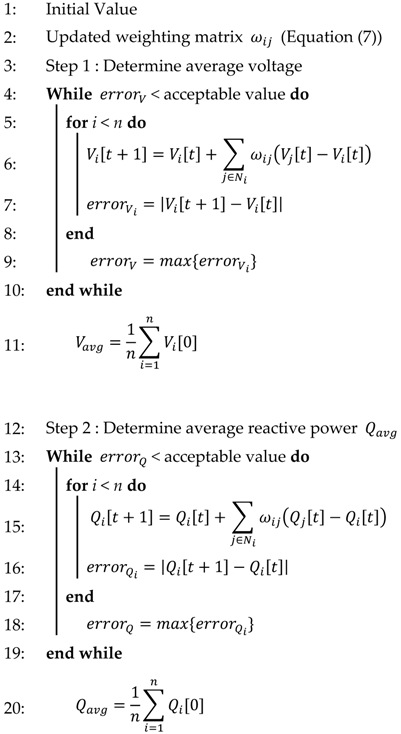 |
4.1. LVRT Operation of the MG System
4.2. Communication Failure from DG
4.3. Communication Failure from the PCC Voltage Measurement
5. Conclusions
Author Contributions
Funding
Acknowledgments
Conflicts of Interest
References
- Hossain, M.A.; Pota, H.R.; Hossain, M.J. Overview of AC Microgrid Controls with Inverter-Interfaced Generations. Energies 2017, 10, 1300. [Google Scholar] [CrossRef]
- Ates, Y.; Boynuegri, A.R.; Uzunoglu, M.; Nadar, A.; Yumurtaci, R.; Erdinc, O.; Paterakis, N.G.; Catalao, J.P.S. Adaptive Protection Scheme for a Distribution System Considering Grid-Connected and Islanded Modes of Operation. Energies 2016, 9, 378. [Google Scholar] [CrossRef]
- Zhang, W.; Rocabert, J.; Candela, J.I.; Rodriguez, P. Synchronous Power Control of Grid-Connected Power Converters under Asymmetrical Grid Fault. Energies 2017, 10, 950. [Google Scholar] [CrossRef]
- Duong, M.Q.; Leva, S.; Mussetta, M.; Le, K.H. A Comparative Study on Controller for Improving Transient Stability of DFIG Wind Turbines during Large Disturbances. Energies 2018, 11, 480. [Google Scholar] [CrossRef]
- Lu, X.; Wang, J.; Guerrero, J.M.; Zhao, D. Virtual-Impedance-Based Fault Current Limiters for Inverter Dominated AC Microgrids. IEEE Trans. Smart Grid 2018, 9, 1599–1612. [Google Scholar] [CrossRef] [Green Version]
- Tsili, M.; Papathanassiou, S. A Review of Grid Code Technical Requirements for Wind Farms. IET Renew. Power Gener. 2009, 3, 308–332. [Google Scholar] [CrossRef]
- Jaalam, N.; Rahim, N.A.; Bakar, A.H.B.A.; Mouneir, B. Strategy to Enhance the Low-Voltage Ride- through in Photovoltaic System During Multi-Mode Transition. Sol. Energy 2017, 154, 744–754. [Google Scholar] [CrossRef]
- Akhlaghi, S.; Sarailoo, M.; Akhlaghi, A.; Ghadimi, A.A. A Novel Hybrid Approach Using SMS and ROCOF for Islanding Detection of Inverter-based DGs. In Proceedings of the IEEE Power and Energy Conference at Illinois (PECI), Champaign, IL, USA, 23–24 February 2017. [Google Scholar]
- Akhlaghi, S.; Ghadimi, A.A.; Akhlaghi, A. A Novel Hybrid Islanding Detection Method Combination of SMS and Q-f for Islanding Detection of Inverter-based DG. In Proceedings of the Power and Energy Conference at Illinois (PECI), Champaign, IL, USA, 28 February–1 March 2014. [Google Scholar]
- Dehnavi, S.D.; Shayani, E. Compensation of Voltage Disturbances in Hybrid AC/DC Microgrids Using Series Converter. Ciênc. Nat. 2015, 37, 349–356. [Google Scholar] [CrossRef]
- Jayawardena, A.V.; Meegahapola, L.G.; Robinson, D.A.; Perera, S. Low-voltage ride-through characteristics of microgrids with distribution static synchronous compensator (DSTATCOM). In Proceedings of the Australasian Universities Power Engineering Conference (AUPEC), Wollongong, Australia, 27–30 September 2015. [Google Scholar]
- Omar, R.; Rahim, N.A. Power Quality Improvement in Low Voltage Distribution System Using Dynamic Voltage Restorer (DVR). In Proceedings of the 5th IEEE Conference on Industrial Electronics and Applications, Taichung, Taiwan, 15–17 June 2010. [Google Scholar]
- Chen, L.; Chen, H.; Yang, J.; Zhu, L.; Tang, Y.; Koh, L.H.; Xu, Y.; Zhang, C.; Liao, Y.; Ren, L. Comparison of Superconducting Fault Current Limiter and Dynamic Voltage Restorer for LVRT Improvement of High Penetration Microgrid. IEEE Trans. Appl. Supercond. 2017, 27, 1–7. [Google Scholar] [CrossRef]
- Chen, L.; He, H.; Zhu, L.; Guo, F.; Shu, Z.; Shi, X.; Yang, J. Coordinated Control of SFCL and SMES for Transient Performance Improvement of Microgrid with Multiple DG Units. Can. J. Electr. Comput. Eng. 2016, 37, 158–167. [Google Scholar] [CrossRef]
- Aplipoor, J.; Miura, Y.; Ise, T. Voltage sag ride-through Performance of Virtual Synchronous Generator. In Proceedings of the International Power Electronics Conference (IPEC), Hiroshima, Japan, 18–21 May 2014. [Google Scholar]
- Shi, K.; Song, W.; Xu, P.; Liu, R.; Fang, Z.; Ji, Y. Low-Voltage Ride-Through Control Strategy for a Virtual Synchronous Generator Based on Smooth Switching. IEEE Access 2017, 6, 2703–2711. [Google Scholar] [CrossRef]
- Lin, F.J.; Lu, K.C.; Yang, B.H. Recurrent Fuzzy Cerebellar Model Articulation Neural Network Based Power Control of a Single-Stage Three-Phase Grid-connected Photovoltaic System during Grid Faults. IEEE Trans. Ind. Electron. 2017, 64, 1258–1268. [Google Scholar] [CrossRef]
- Lin, F.J.; Lu, K.C.; Ke, T.H. Probabilistic Wavelet Fuzzy Neural Network based reactive power control for grid-connected three-phase PV system during grid faults. Renew. Energy 2016, 92, 437–449. [Google Scholar] [CrossRef]
- Rajamand, S.; Ketabi, A.; Zahedi, A. A New LVRT Strategy for DGs with Different Droop Gains in Islanded Microgrid with Various Loads. EPE J. 2018, 28, 1–12. [Google Scholar] [CrossRef]
- Lee, C.T.; Hsu, C.W.; Cheng, P.T. A Low-Voltage Ride-Through Technique for Grid-Connected Converters of Distributed Energy Resources. IEEE Trans. Ind. Appl. 2011, 47, 1821–1832. [Google Scholar] [CrossRef]
- Zhao, X.; Guerrero, J.M.; Savaghebi, M.; Vasquez, J.C.; Wu, X.; Sun, K. Low-Voltage Ride-Through Operation of Power Converters in Grid-Interactive Microgrids by Using Negative-Sequence Droop Control. IEEE Trans. Power Electron. 2016, 31, 3128–3142. [Google Scholar] [CrossRef]
- Sadeghkhani, I.; Golshan, M.E.H.; Sani, A.M.; Guerrero, J.M. Low-voltage ride-through of a Droop-based Three-phase Four-wire Grid-connected Microgrid. IET Gener. Trans. Distrib. 2018, 12, 1906–1914. [Google Scholar] [CrossRef]
- Liu, X.; Xu, Z.; Wong, K.P. Recent Advancement on Technical Requirements for Grid Integration of Wind Power. Mod. Power Syst. Clean Energy 2013, 1, 216–222. [Google Scholar] [CrossRef]
- Mohseni, M.; Islam, S.M. Review of International Grid Codes for Wind Power Integration: Diversity, technology and a case for global standard. Renew. Sustain. Energy Rev. 2012, 16, 3876–3890. [Google Scholar] [CrossRef]
- Kish, G.J.; Lehn, P.W. Microgrid Design Considerations for Next Generation Grid Codes. In Proceedings of the IEEE Power and Energy Society General Meeting, San Diego, CA, USA, 22–26 July 2012. [Google Scholar]
- Erlich, I.; Bachmann, U. Grid Code Requirements Concerning Connection and Operation of Wind Turbines in Germany. In Proceedings of the IEEE Power Engineering Society General Meeting, San Francisco, CA, USA, 16 June 2005. [Google Scholar]
- Ruitenbeek, E.V.; Boemer, J.C.; Skaloumpakas, K.; Torres, J.L.R.; Gibescu, M.; Mart, A.M.M.; Meijden, M.A.M.M. A Proposal for New Requirements for the Fault Behaviour of Distributed Generation Connected to Low Voltage Networks. In Proceedings of the 4th Solar Integration Workshop, Berlin, Germany, 10–11 November 2014. [Google Scholar]
- Zhou, J.; Kim, S.; Zhang, H.; Sun, Q.; Han, R. Consensus-Based Distributed Control for Accurate Reactive, Harmonic, and Imbalance Power Sharing in Microgrids. IEEE Trans. Smart Grid 2018, 9, 2453–2467. [Google Scholar] [CrossRef] [Green Version]
- Liu, W.; Gu, W.; Sheng, W.; Meng, X.; Wu, Z.; Chen, W. Decentralized Multi-Agent System-Based Cooperative Frequency Control for Autonomous Microgrids with Communication Constraints. IEEE Trans. Sustain. Energy 2014, 5, 446–456. [Google Scholar] [CrossRef]

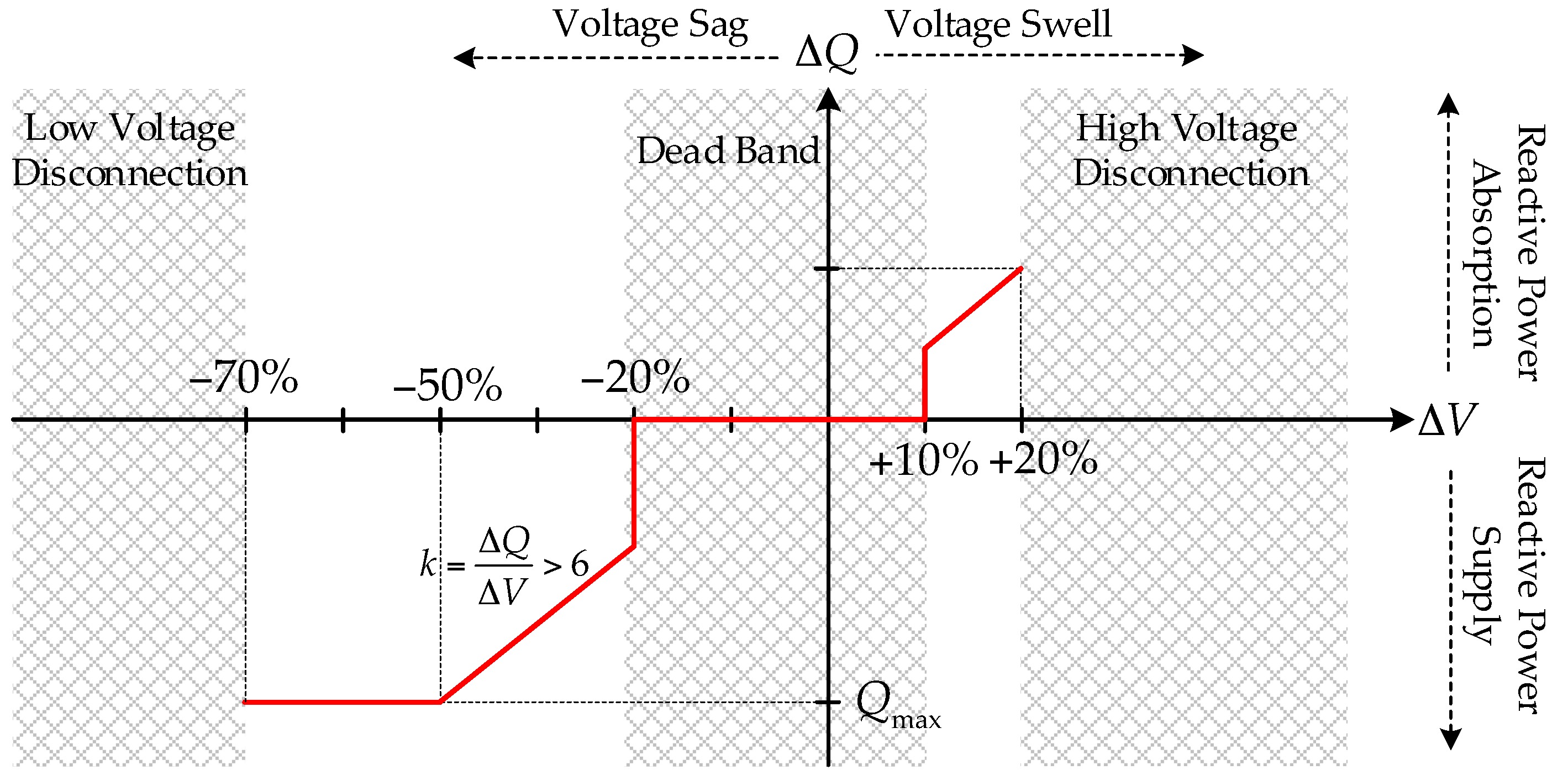
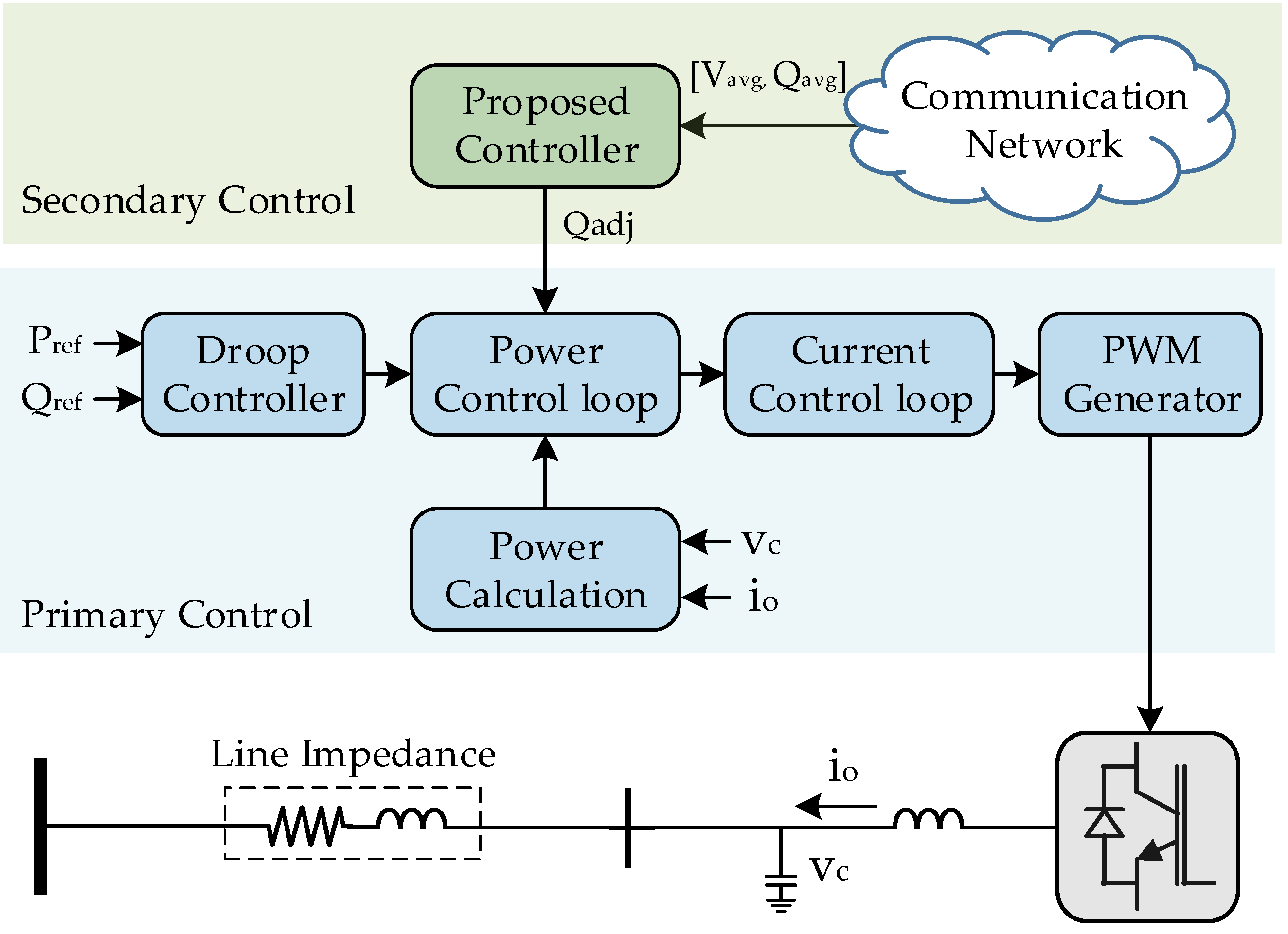
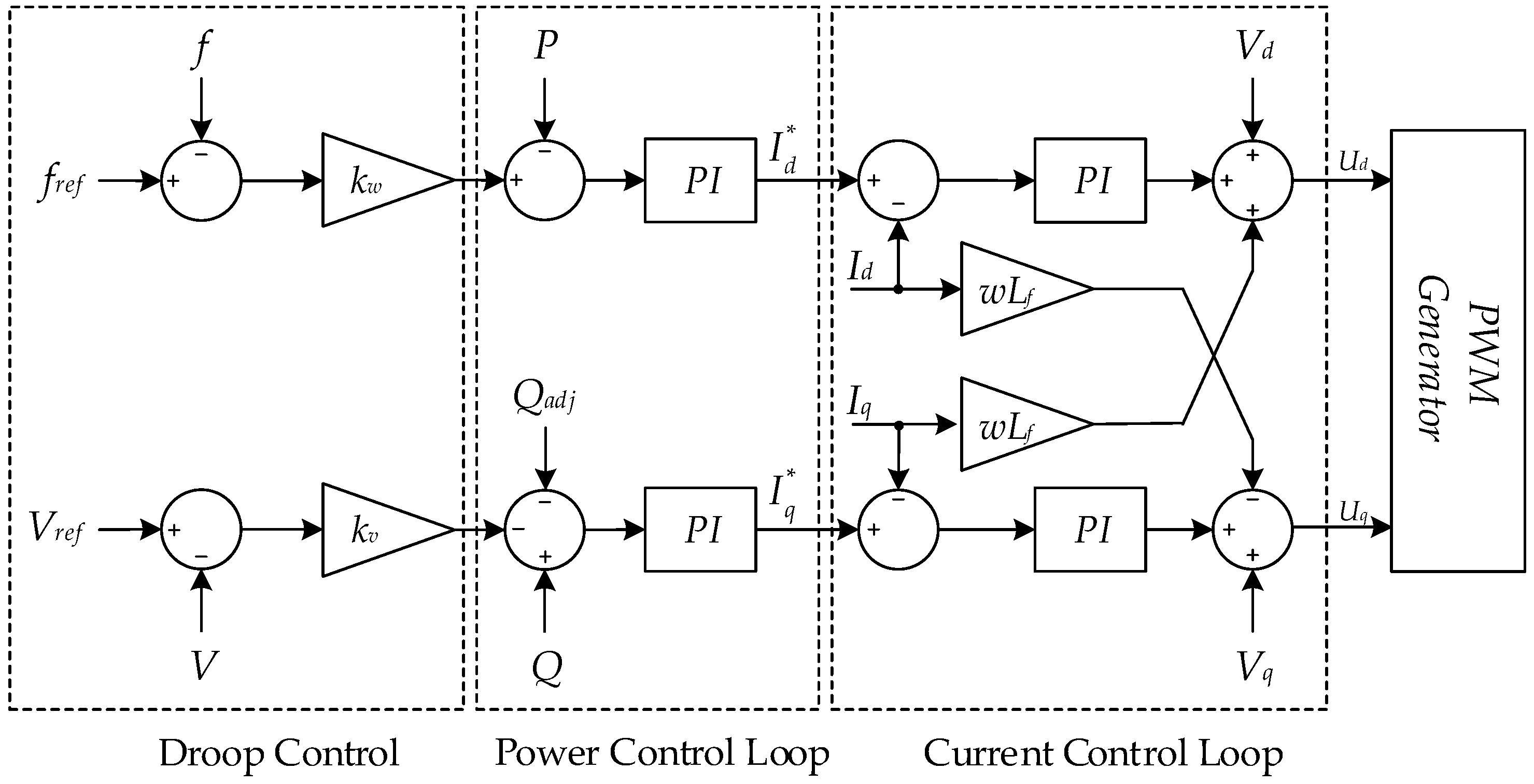
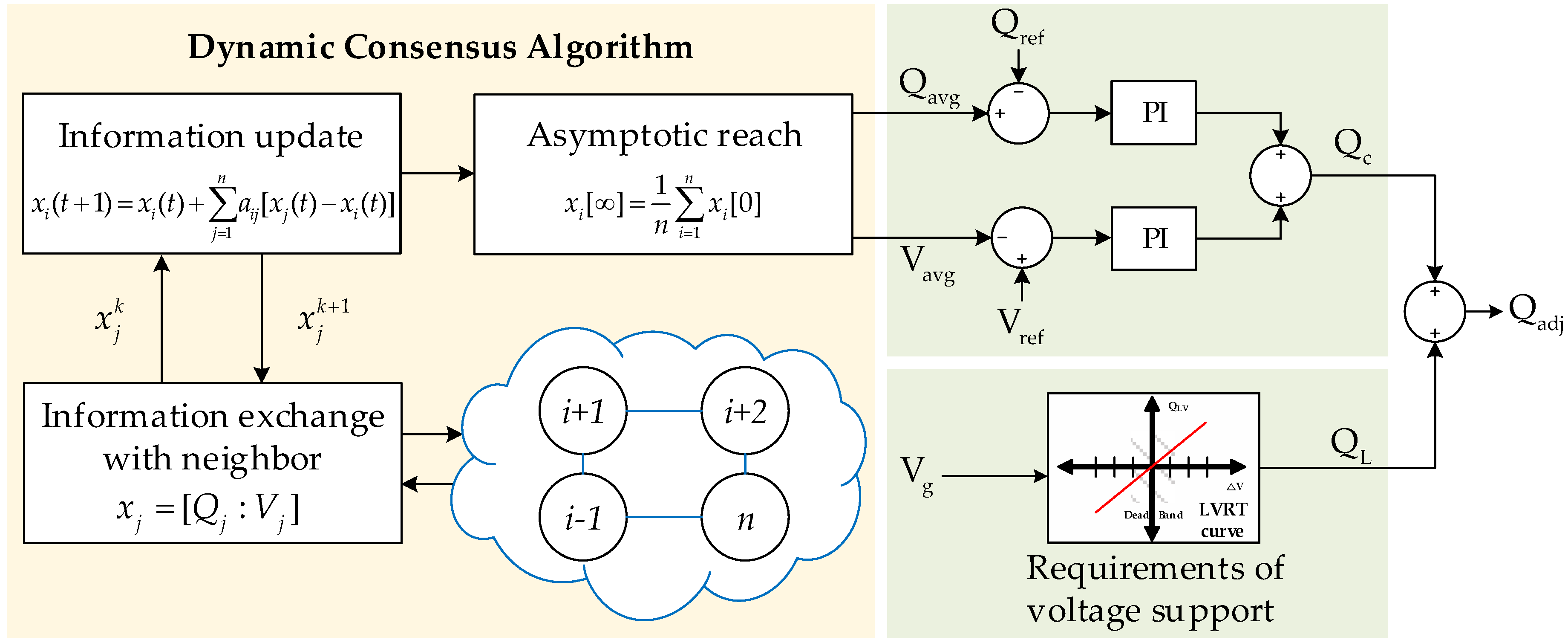
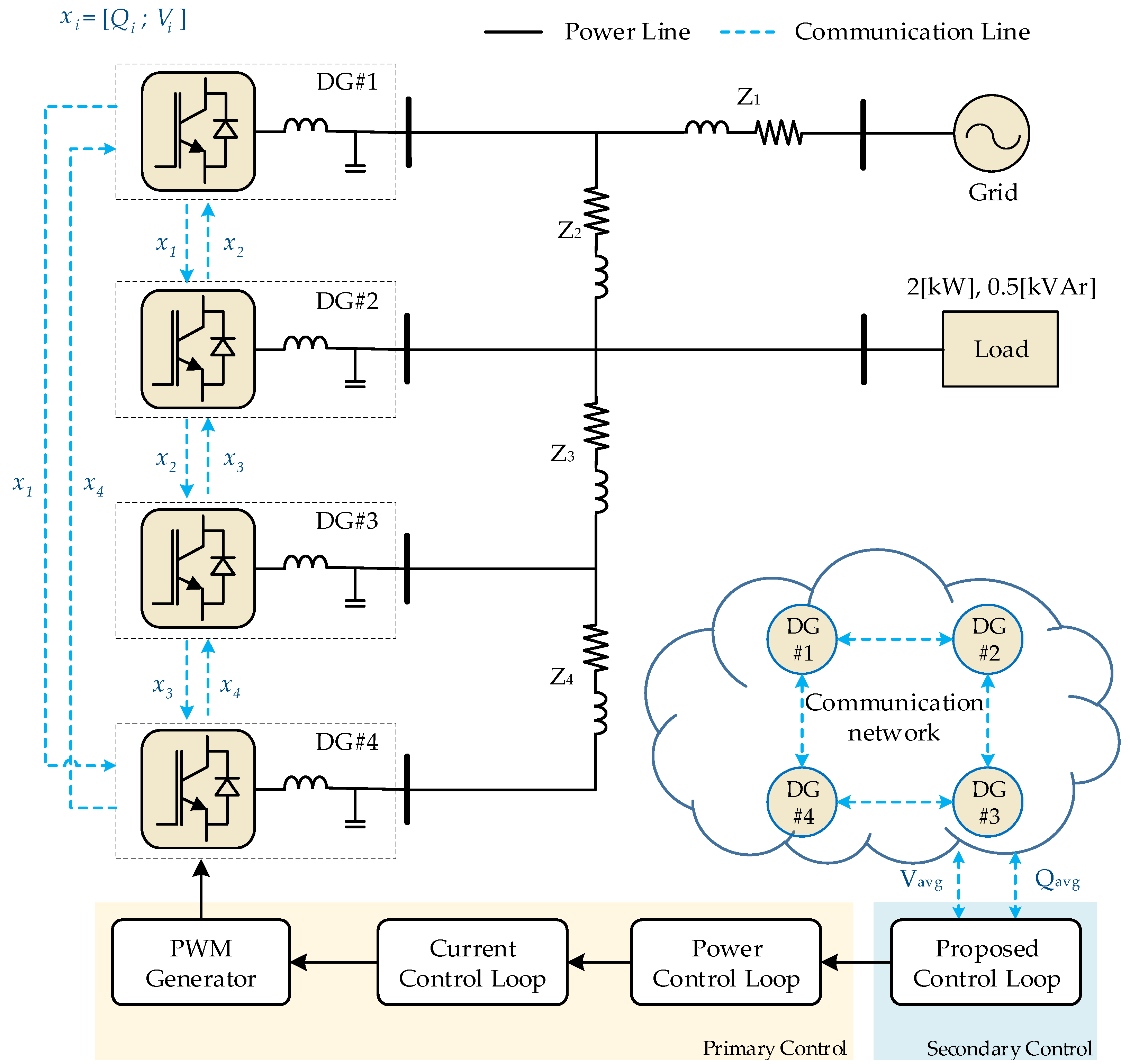
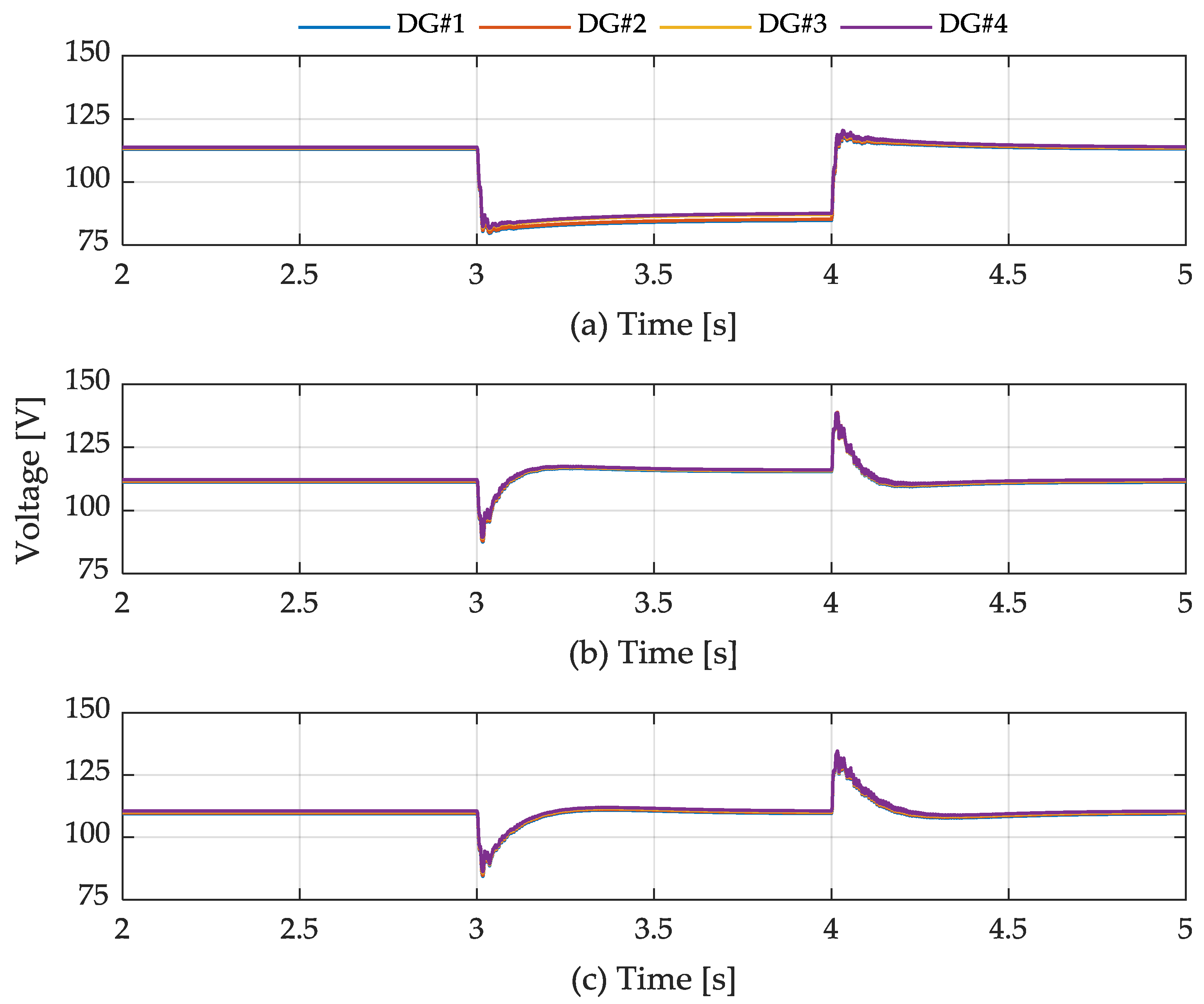

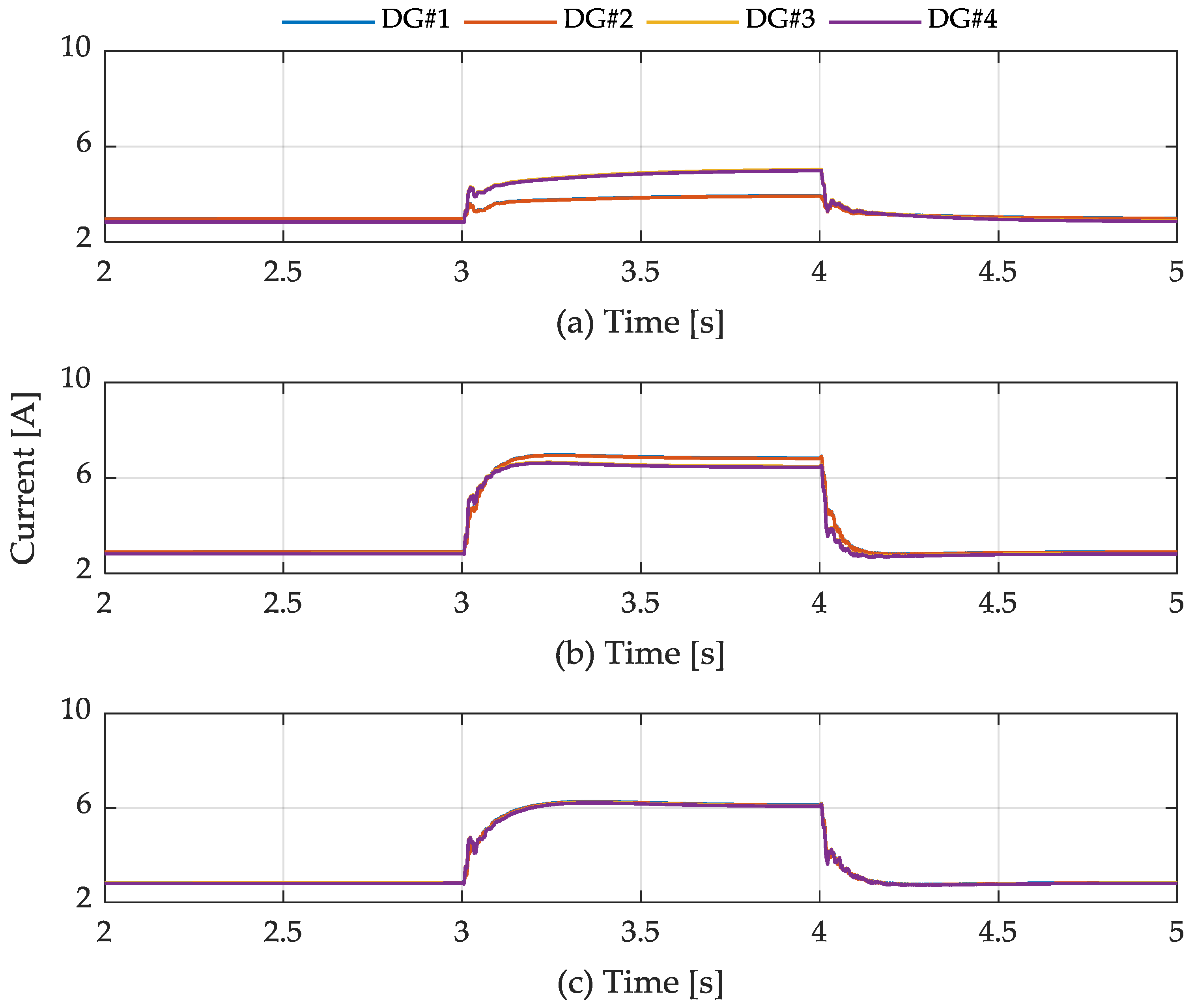

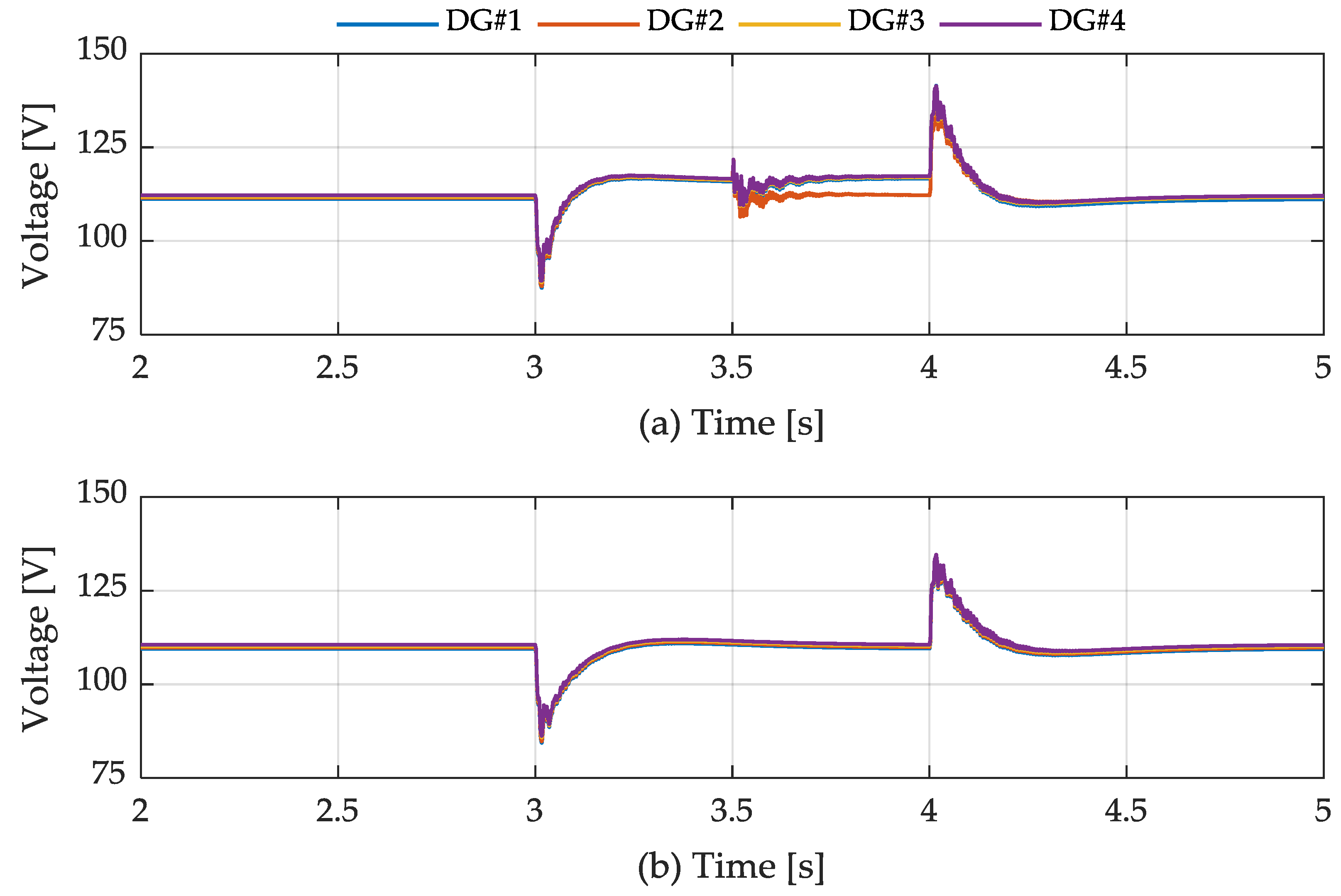

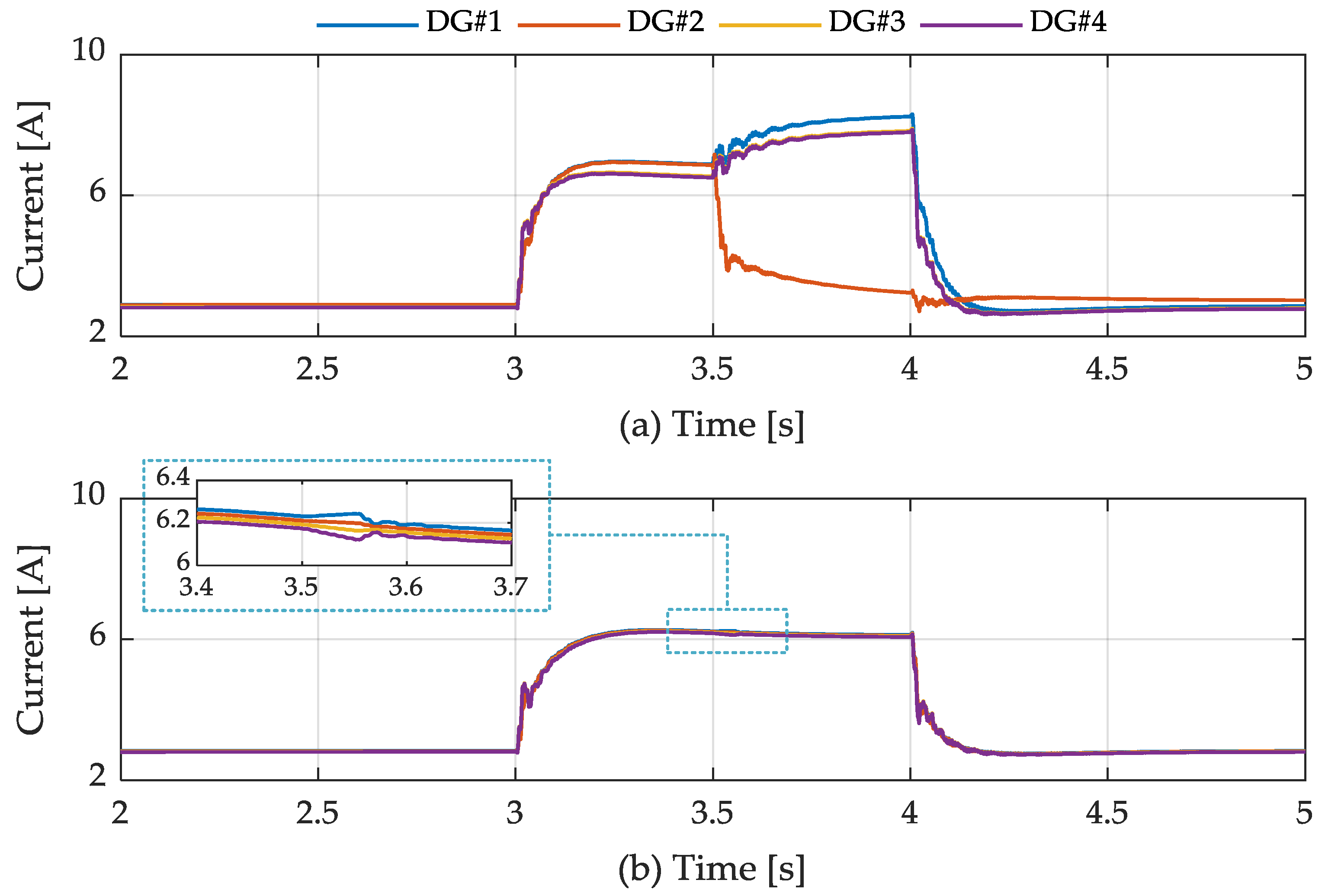
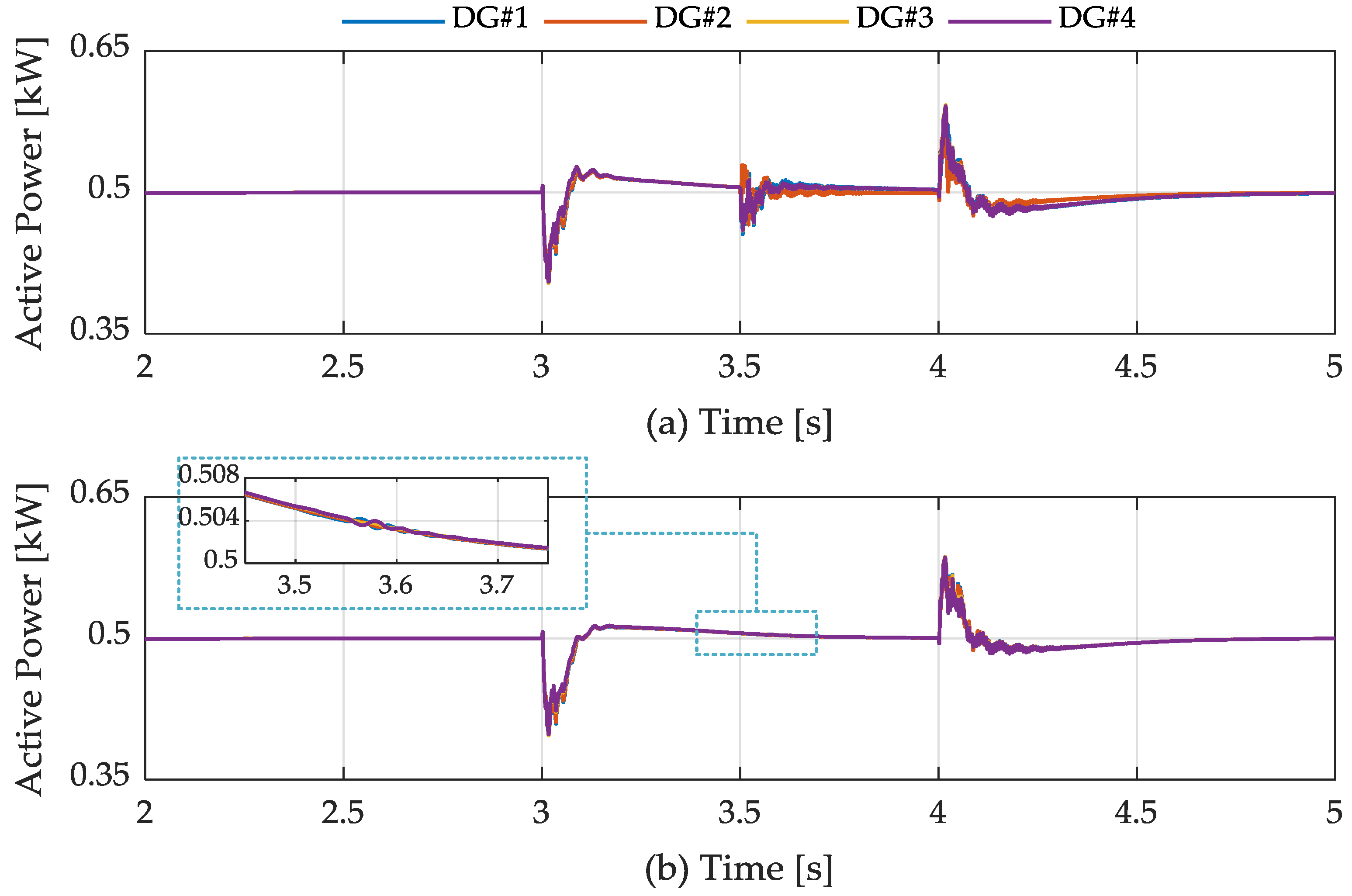
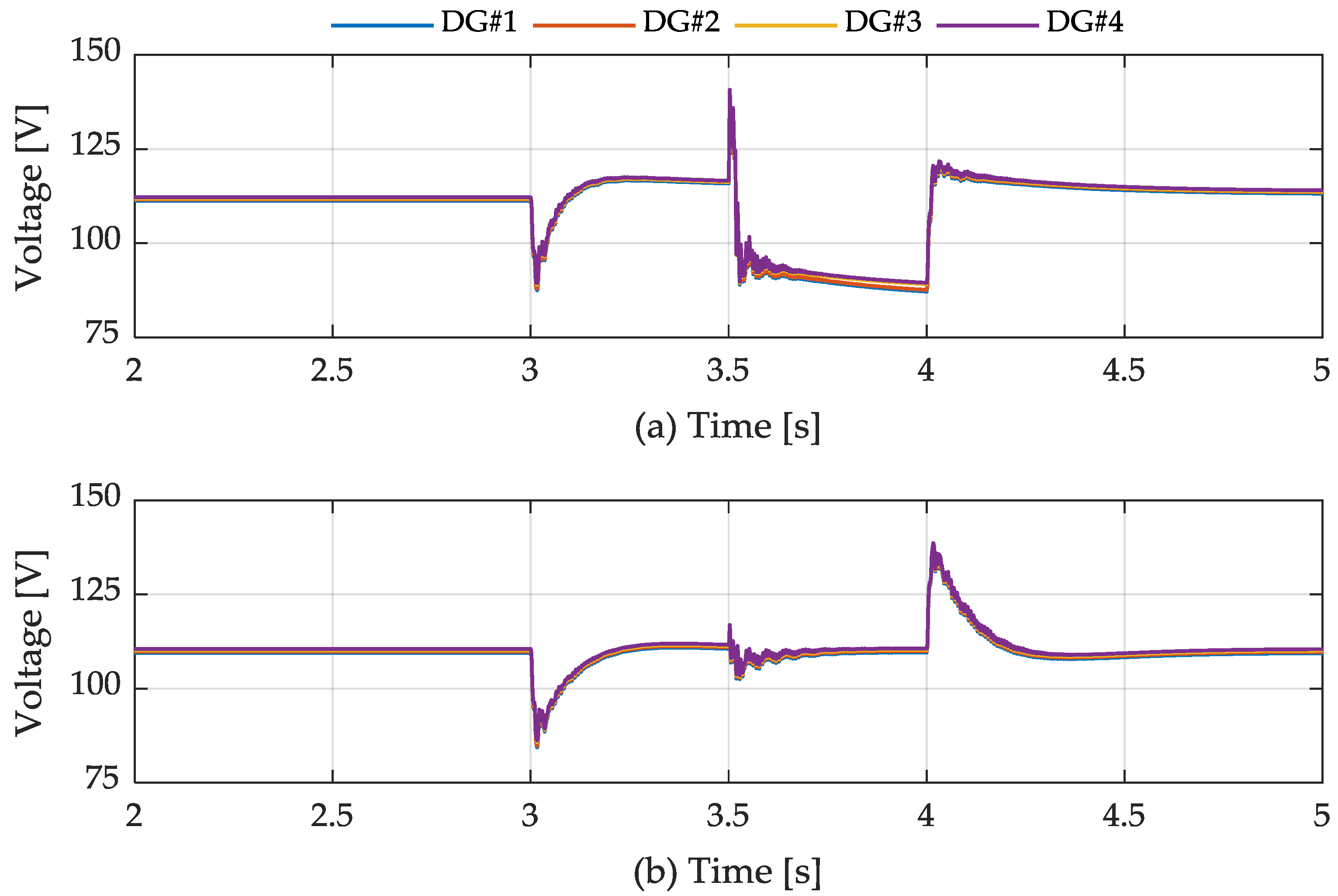
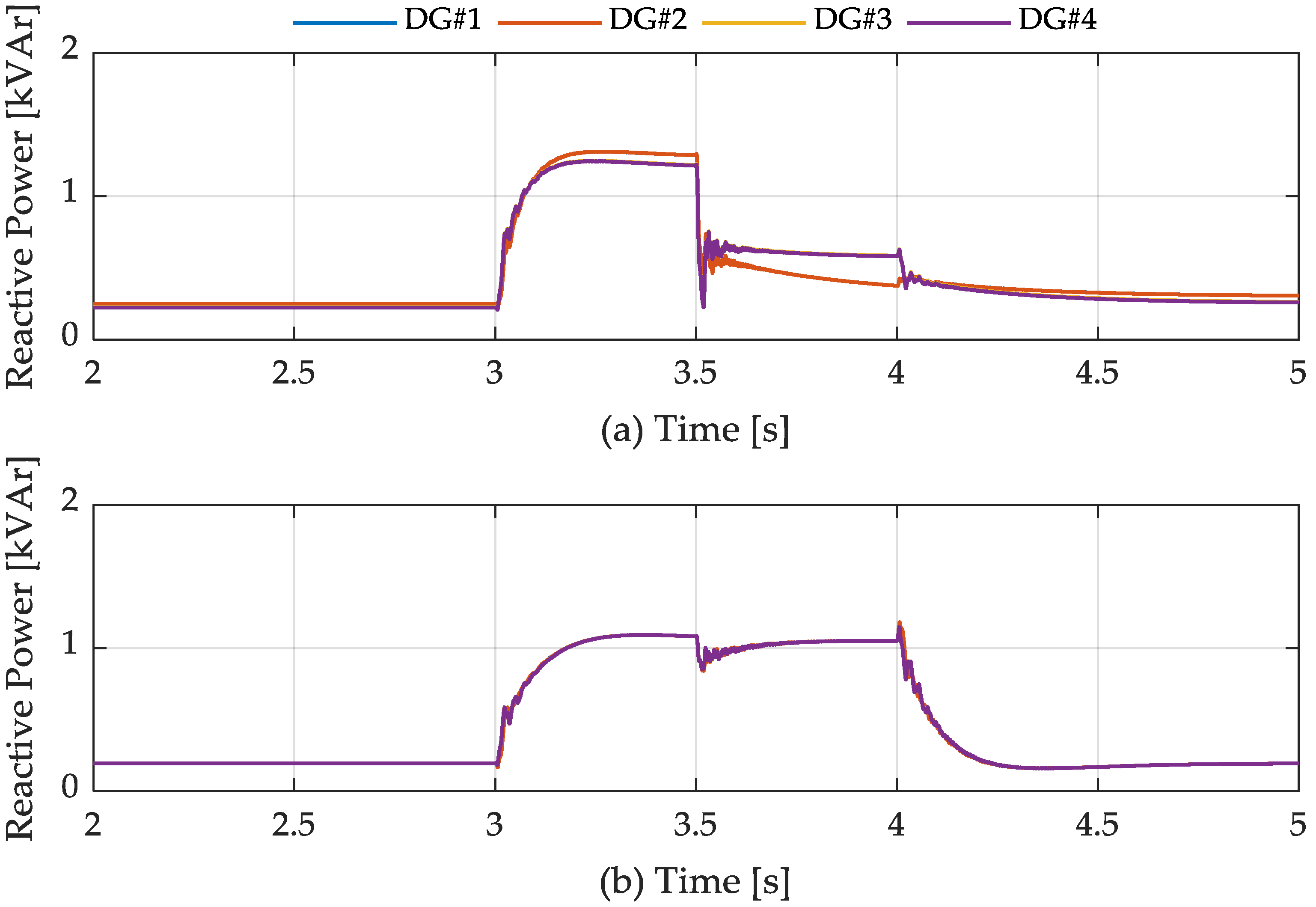
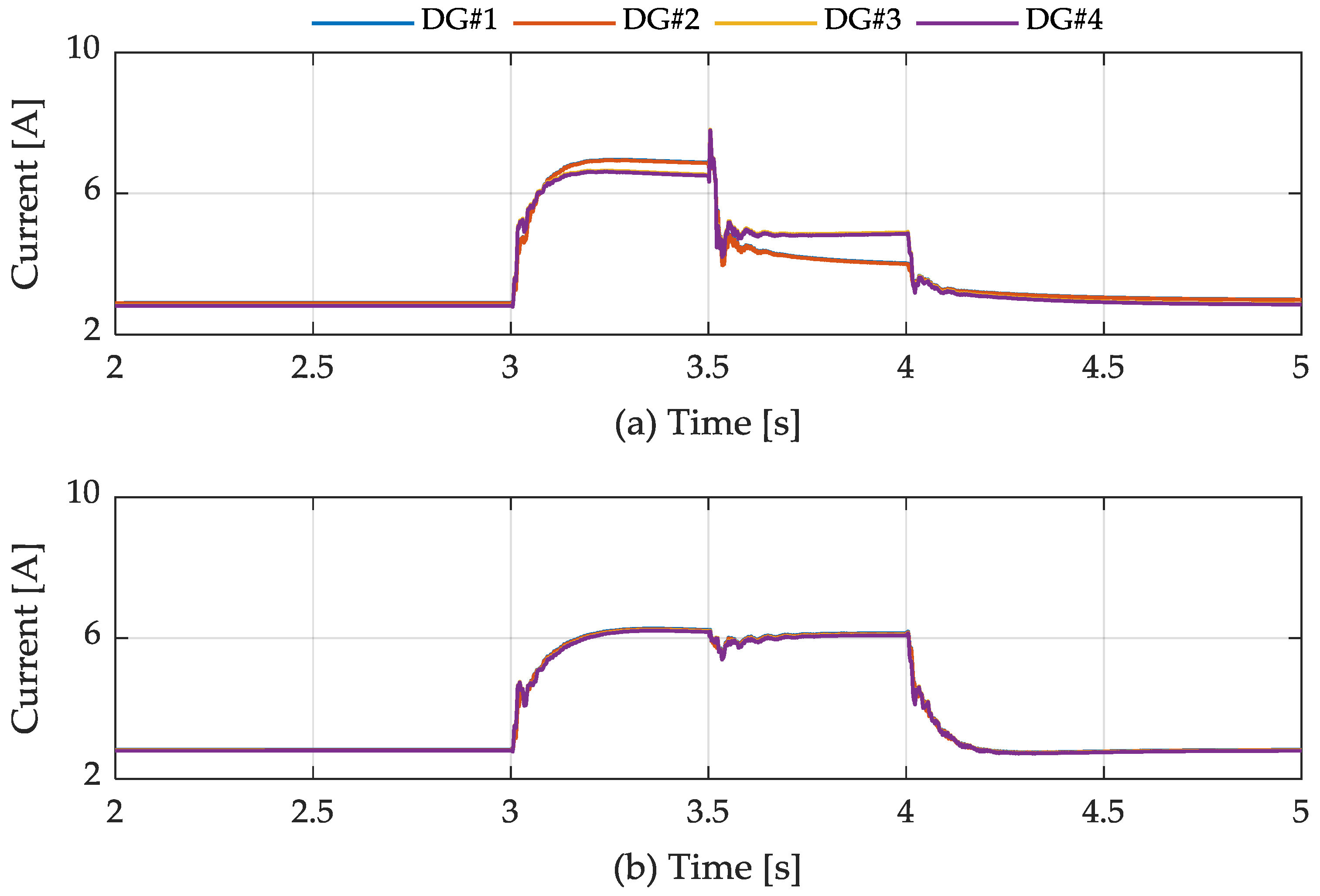
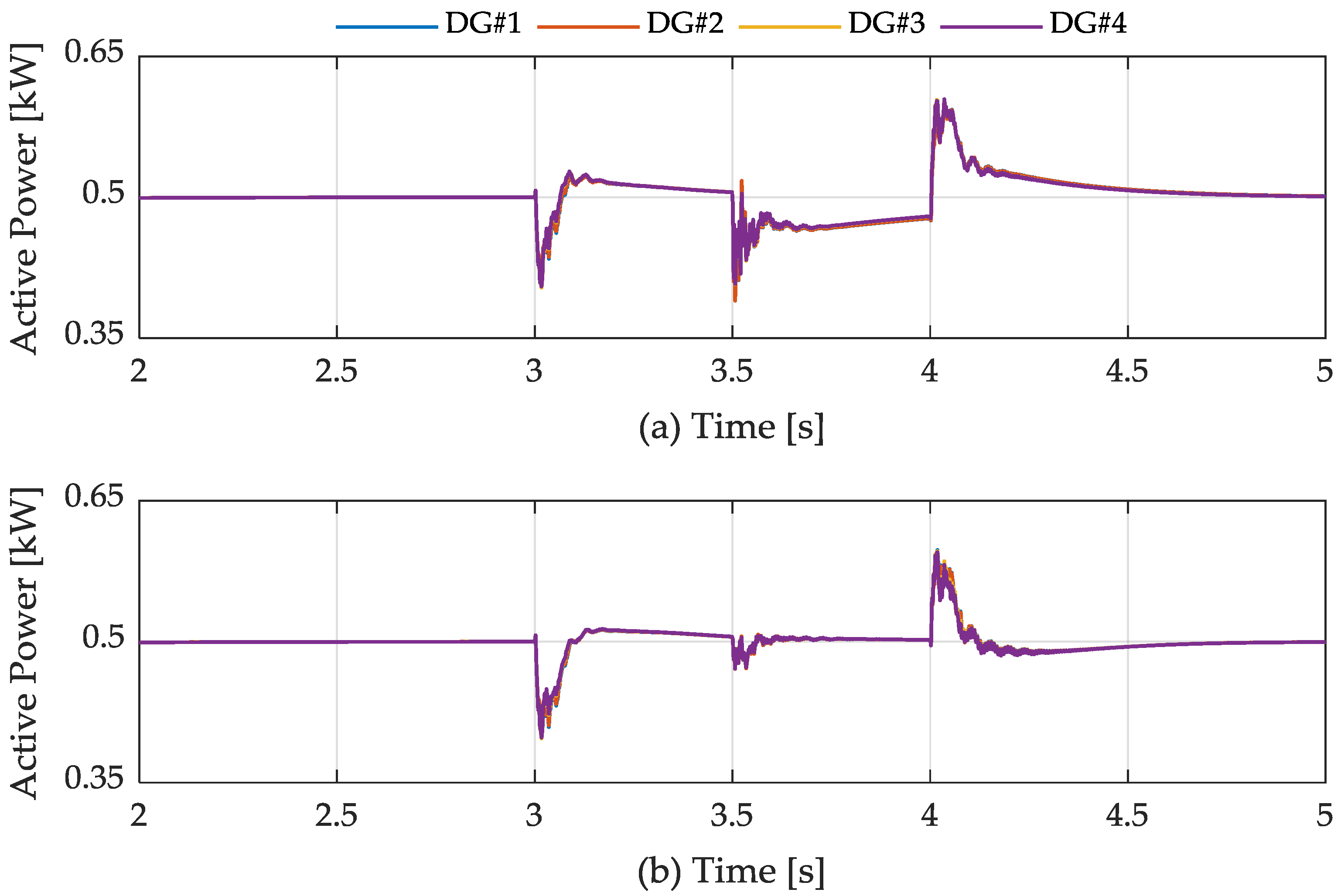
| Symbol | Parameters | Value | Unit |
|---|---|---|---|
| Rated RMS voltage | V | ||
| Rated voltage frequency | Hz | ||
| Switching frequency | kHz | ||
| Filter inductance | mH | ||
| Filter capacitance | |||
| Primary power controller proportional coefficient | - | ||
| Primary power controller integral coefficient | - | ||
| Primary current controller proportional coefficient | - | ||
| Primary current controller integral coefficient | - | ||
| Secondary reactive power controller proportional coefficient | 0.5 | - | |
| Secondary reactive power controller integral coefficient | 300 | - | |
| Secondary voltage controller proportional coefficient | 0.8 | - | |
| Secondary voltage controller integral coefficient | 200 | - | |
| Line impdance#1 | 0.08 + j0.94 | Ω | |
| Line impdance#2 | 0.04 + j0.46 | Ω | |
| Line impdance#3 | 0.06 + j0.62 | Ω | |
| Line impdance#4 | 0.06 + j0.62 | Ω |
© 2018 by the authors. Licensee MDPI, Basel, Switzerland. This article is an open access article distributed under the terms and conditions of the Creative Commons Attribution (CC BY) license (http://creativecommons.org/licenses/by/4.0/).
Share and Cite
Lee, W.-G.; Nguyen, T.-T.; Yoo, H.-J.; Kim, H.-M. Low-Voltage Ride-Through Operation of Grid-Connected Microgrid Using Consensus-Based Distributed Control. Energies 2018, 11, 2867. https://doi.org/10.3390/en11112867
Lee W-G, Nguyen T-T, Yoo H-J, Kim H-M. Low-Voltage Ride-Through Operation of Grid-Connected Microgrid Using Consensus-Based Distributed Control. Energies. 2018; 11(11):2867. https://doi.org/10.3390/en11112867
Chicago/Turabian StyleLee, Woon-Gyu, Thai-Thanh Nguyen, Hyeong-Jun Yoo, and Hak-Man Kim. 2018. "Low-Voltage Ride-Through Operation of Grid-Connected Microgrid Using Consensus-Based Distributed Control" Energies 11, no. 11: 2867. https://doi.org/10.3390/en11112867





